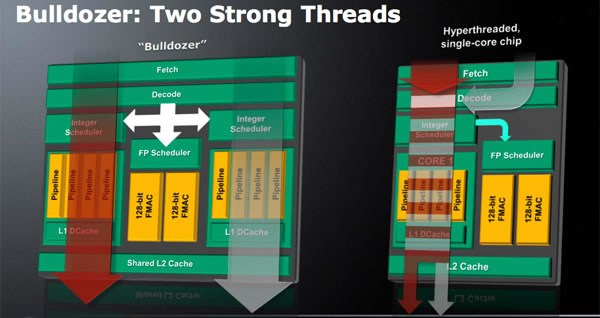Speaking at Stanford University's Hot Chips conference this week, AMD offered up some new details about their most significant processor redesign since the K8 architecture in 2003, which made Athlon 64 processors favorites among enthusiasts. Specifically, the company talked about two x86 processor cores aimed at different ends of the market: Bobcat, which will be a low-power core aimed at netbooks, tablets and other portable devices where it will compete with Intel's Atom, and Bulldozer which will be used in multiple-core server and desktop chips due out next year.
Both micro-architectures form the basis of AMD's upcoming Fusion line of chips that combine a CPU and a DirectX 11-capable GPU completely integrated in the same piece of silicon – unlike Intel's current Core i3 and i5 processors, which bundle two discrete pieces of silicon on one package, but rather similar to their upcoming Sandy Bridge architecture.
AMD claims that Bobcat can deliver 90% of the performance of today's mainstream chips in about half the area, and touted the ability for the core to run on less than one watt of power by lowering operating frequencies and voltages. Unlike Atom, Bobcat will support out-of-order instruction handling, allowing for instructions to run in parallel and therefore offering improved performance. Bobcat is the processor core that will show up in upcoming 32nm Ontario parts (known as accelerated processing units, or APUs, according to AMD's official parlance) due out in early 2011.

Processors based on Bulldozer will show up sometime next year with up to 16-core arrangements and should perform up to 50% faster than chips based on earlier architectures. The company is focusing on performance and scalability by using a modular design that combines dedicated and shared components: each Bulldozer module actually contains two single threaded cores, which share a floating point scheduler with two 128-bit floating-point math units, but have their own integer schedulers and execution pipelines. AMD believes approach will allow two threads to be processed in parallel much quicker than with Intel's Hyper-Threading technology. As the company sees it, it's multithreading done right.
AMD is promising to share more details during the week. In the meantime, for a more in-depth look at their upcoming Bobcat and Bulldozer architectures you can check out this article at Anandtech.